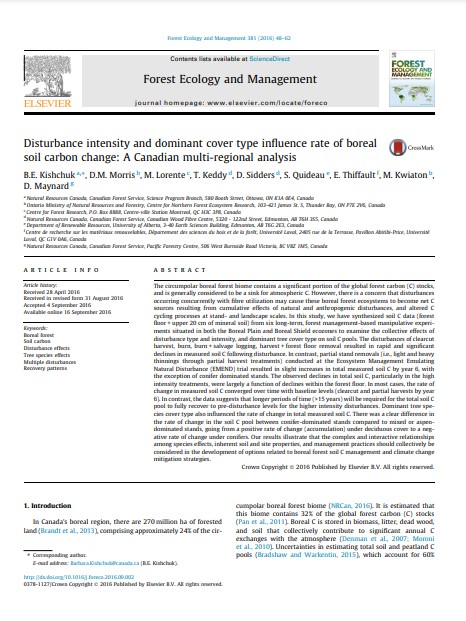Disturbance intensity and dominant cover type influence rate of boreal soil carbon change: A Canadian multi-regional analysis
Bosque Modelo:
Foothills
Temática:
Gestión forestal
Tipo de documento:
Artículo científico
Resumen
The circumpolar boreal forest biome contains a significant portion of the global forest carbon (C) stocks, and is generally considered to be a sink for atmospheric C. However, there is a concern that disturbances occurring concurrently with fibre utilization may cause these boreal forest ecosystems to become net C sources resulting from cumulative effects of natural and anthropogenic disturbances, and altered cycling processes at stand- and landscape scales. In this study, we have synthesized soil C data (forest floor + upper 20 cm of mineral soil) from six long-term, forest management-based manipulative experiments situated in both the Boreal Plain and Boreal Shield ecozones to examine the collective effects of disturbance type and intensity, and dominant tree cover type on soil C pools. The disturbances of clearcut harvest, burn, burn + salvage logging, harvest + forest floor removal resulted in rapid and significant declines in measured soil C following disturbance. In contrast, partial stand removals (i.e., light and heavy thinnings through partial harvest treatments) conducted at the Ecosystem Management Emulating Natural Disturbance (EMEND) trial resulted in slight increases in total measured soil C by year 6, with the exception of conifer dominated stands. The observed declines in total soil C, particularly in the high intensity treatments, were largely a function of declines within the forest floor. In most cases, the rate of change in measured soil C converged over time with baseline levels (clearcut and partial harvests by year 6). In contrast, the data suggests that longer periods of time (>15 years) will be required for the total soil C pool to fully recover to pre-disturbance levels for the higher intensity disturbances. Dominant tree species cover type also influenced the rate of change in total measured soil C. There was a clear difference in the rate of change in the soil C pool between conifer-dominated stands compared to mixed or aspendominated stands, going from a positive rate of change (accumulation) under deciduous cover to a negative rate of change under conifers. Our results illustrate that the complex and interactive relationships
among species effects, inherent soil and site properties, and management practices should collectively be considered in the development of options related to boreal forest soil C management and climate change mitigation strategies.
Información Bibliográfica
Autor:
Kishchuk, B. E.; Morris, D. M.; Lorente, M.; Keddy, T.; Sidders, D.; Quideau, S.; Thiffault, E.; Kwiaton, M.; Maynard, D.
Revista:
FOREST ECOLOGY AND MANAGEMENT
Año:
2016
N°:
-
País :
Canadá
Páginas:
48 - 62
Volumen:
381
Idioma:
Ingles
Palabras claves
Boreal forest Soil carbon Disturbance effects Tree species effects Multiple disturbances Recovery patterns





